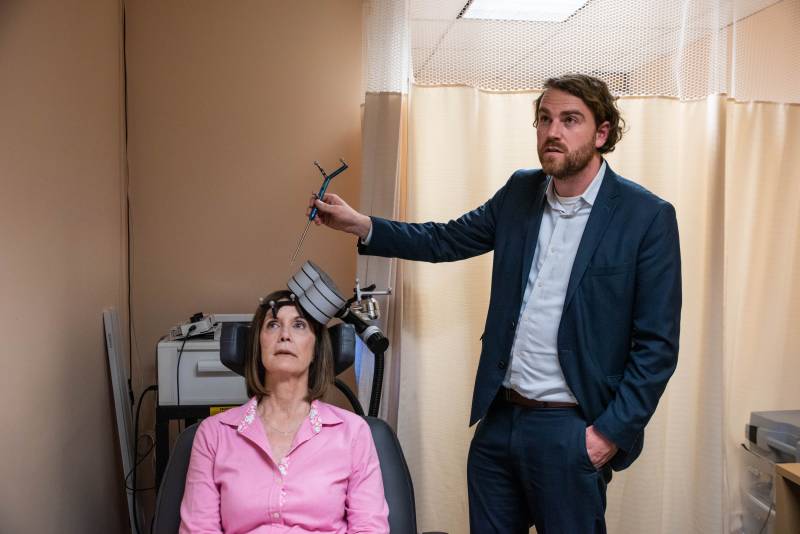Three years ago, Emma’s psychiatrist urged her to enroll in a study at Stanford University School of Medicine designed for people who had run out of options. When she arrived, scientists took an MRI scan to determine the best possible location to deliver electrical pulses to her brain. Then for 10 hours a day for five consecutive days, Emma sat in a chair while a magnetic field stimulated her brain.
At the end of the first day, an unfamiliar calm settled over Emma. Even when her partner picked her up to drive home, she stayed relaxed. “I’m usually hysterical,” she said. “All the time I'm grabbing things. I'm yelling, you know, ‘Did you see those lights?’ And while I rode home that first night I just looked out the window and I enjoyed the ride.”
The remedy was a new type of repetitive transcranial magnetic stimulation (rTMS) called "Stanford neuromodulation therapy." By adding imaging technology to the treatment and upping the dose of rTMS, scientists have developed an approach that’s more effective and works more than eight times faster than the current approved treatment.

A coil on top of Emma’s head created a magnetic field that sent electric pulses through her skull to tickle the surface of her brain. She says it felt like a woodpecker tapped on her skull every 15 seconds. The electrical current is directed at the prefrontal cortex, which is the part of the brain that plans, dreams and controls our emotions.
“It’s an area thought to be underactive in depression,” said Nolan Williams, a psychiatrist and rTMS researcher at Stanford. “We send a signal for the system to not only turn on, but to stay on and remember to stay on.”
Nolan says pumping up the prefrontal cortex helps turn down other areas of the brain that stimulate fear and anxiety. That’s the basic premise of rTMS: Electrical impulses are used to balance out erratic brain activity. As a result, people feel less depressed and more in control. All of this holds true in the new treatment — it just works faster.
A recent randomized control trial, published in The American Journal of Psychiatry, shows astounding results are possible in five days or less. Almost 80% of patients crossed into remission — meaning they were symptom-free within days. This is compared to about 13% of people who received the placebo treatment. Patients did not report any serious side effects. The most common complaint was a light headache.
Stanford’s new delivery system may even outperform electroconvulsive therapy, which is the most popular form of brain stimulation for depression, but it requires both general anesthesia and a full medical team.
“This study not only showed some of the best remission rates we've ever seen in depression,” said Shan Siddiqi, a Harvard psychiatrist not connected to the study, “but also managed to do that in people who had already failed multiple other treatments.”
Siddiqi also said the study’s small sample size, which is only 29 patients, is not cause for concern.
“Often, a clinical trial will be terminated early [according to pre-specified criteria] because the treatment is so effective that it would be unethical to continue giving people placebo,” said Siddiqi. “That's what happened here. They'd originally planned to recruit a much larger sample, but the interim analysis was definitive.”
Mark George, a psychiatrist and neurologist at the Medical University of South Carolina, agrees. He points to other similarly sized trials for depression treatments like ketamine, a version of which is now FDA-approved.
He says the new rTMS approach could be a game changer because it’s both more precise and faster. George pioneered an rTMS treatment that was approved by the federal Food and Drug Administration for depression in 2008. Studies show that: It produces a near total loss of symptoms in about a third of patients; another third feel somewhat better; and another third do not respond at all. But the main problem with the original treatment is that it takes six weeks, which is a long time for a patient in the midst of a crisis.
from Hacker News https://ift.tt/321VlYl
No comments:
Post a Comment
Note: Only a member of this blog may post a comment.